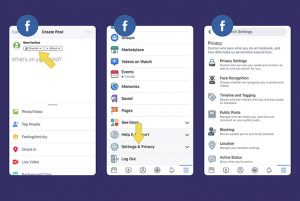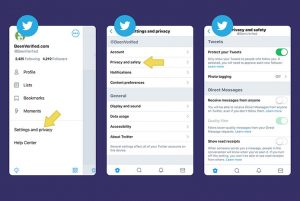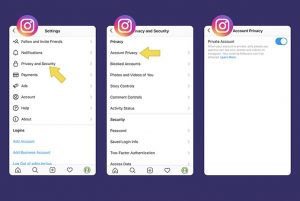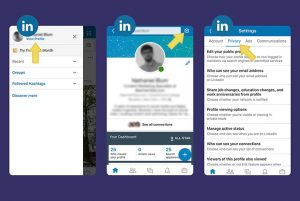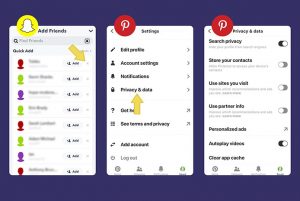It’s hard to deny the benefits of social media: We can stay in touch with friends and family near and far, meet new people, and even find communities of like-minded strangers who share the same interests and hobbies. No wonder 69% of Americans use some form of social media, according to the Pew Research Center. But there are also downsides, especially when it comes to protecting your online privacy.
Social media privacy is a concern for anyone who has an online presence. The 2018 Cambridge Analytica scandal that exposed the data of 87 million Facebook users is a stark reminder of just how susceptible our collective information—from photos to where we live and who are in our network of friends—can be in the wrong hands.
“Cybercrime is a growing problem, and there’s a high chance you’ll be a victim in your lifetime—if you haven’t already,” said Mark Grabowski, an associate professor specializing in internet law and digital ethics at Adelphi University in Garden City, New York.
“Your guard should be raised when it comes to social media. Hacking and scams are especially rampant in this part of the internet.” But that doesn’t mean you have to go completely dark on social. Instead, understand how each platform uses your data and take the necessary steps to guard your privacy. It can go a long way in protecting your digital identity.
Social media privacy: What you need to know
When you sign up for a new social media account, you typically create an online profile with your full name, email address and location. In most cases, you may also be asked to connect with offline friends on the platform or you may be matched to people with similar interests and demographics.
According to Privacy Rights Clearinghouse, a nonprofit championing consumer privacy protections, every social network lets users post information—including names, posts or even your entire account—that is publicly accessible.
However, you may not have complete control over the type of data being shared, even if your account is set to private. For example, people in your approved friends list may be able to share information, such as photos, without your permission. On Facebook, any photo in which you tag a friend can also be seen by your friend’s network, who may be strangers to you.
Your personal information—such as where you live, your relationship status and your behavioral and demographic traits—are valuable to advertisers, who target their marketing messages and ads based on your personal information. What’s much more worrisome, though, are third-party applications—programs that aren’t part of a social media network but can access the platform. Think online quizzes (like the “This Is Your Digital Life” personality quiz that led to the Cambridge Analytica scandal), games and other websites that allow you to log in using your social media profile. Once you grant a third-party app permission to access your account, it has access to your online identity without necessarily being bound by the privacy policy offered by the social media platform.
Even if you’ve done your homework and reviewed a social media platform’s privacy policy, remember that it can change at any time. In other words, it’s the responsibility of the user to stay on top of social media privacy policies and how they work.
Social media safety do’s and don’ts
When engaging on social media, what may seem like a harmless post—like your current location, your political views or even your shopping habits—can be valuable information for advertisers, spam bots and even hackers.
“One of the biggest mistakes you can make is posting about your vacation while you are still there,” said Grabowski. “Someone searching on social media who happens to see your vacation post might decide that while you’re away your home is ideal for looting.”
To minimize your chances of having your data breached (check here to see if your data has been compromised), follow these social media safety tips:|
- Review the privacy policy.Before signing up for a new social media account, read over the company’s privacy policy to see what it intends to do with your information and data. Look for how the information is collected, stored and used—and who will have access to it.
- Use a strong password.Antivirus software providers recommend creating a unique and complex password for each account. For example, use an alphanumeric password that’s at least 12 characters long (or the maximum allowed). Also, consider changing it every 90 days to reduce the chance of someone figuring it out.
- Be careful what you share.Sensitive information, such as your birthday, age, phone number and location, may be useful to data miners and identity thieves. You may also want to turn off the GPS settings when you share posts to avoid revealing your location.
- Log in to your account manually.This will ensure bad actors can’t access your social media accounts in case your device gets stolen or hacked. By that same token, always log out to protect your account.
- Don’t accept friend requests from strangers.Be careful of people you don’t know. Even if you do, click over to their profile to make sure it’s not a fake account trying to access your sensitive information. “Cybercriminals may impersonate people you know online,” Grabowski said. For example, Twitter has been overtaken with accounts that impersonate people who promise thousands of bitcoins in return for a small amount of a cryptocurrency to fraudulent accounts.
- Be wary of third-party applications.Remember, third-party apps may have different privacy settings. Before linking your social media profile, review its privacy policy and terms of use.
Privacy settings on your social media accounts
If you haven’t already, understand and use the privacy settings on the social media platforms you use. Each platform offers different privacy options, but here are the six most popular social networks and how you can access and change your account settings.
Facebook privacy settings
Facebook users today: 2.38 billion worldwide
Facebook privacy issues: In July 2018, more than 800,000 users were affected by a bug that unblocked users. Two months later, in September, more than 50 million accounts were affected by a security breach that let attackers access some Facebook profiles.
How to make your Facebook page private: Facebook has several options on how to keep your posts private. You can share certain photos, posts and other identifying information to what Facebook calls “audiences.”
These options include:
- Public:Anyone can see this information, including non-Facebook users.
- Friends:This includes your Facebook friends.
- Custom:You can create lists of friends, then either share information with or block information from certain friends or friend lists.
- Only me:Only you can see it.
Ways to keep your Facebook information private:
- Before you post:A button with a drop-down menu allows you to choose your audience. Once you change your audience setting, it will remain the same on future posts—unless you update it. You can also edit previous individual posts by changing the audience setting on the post. To adjust the audience setting on multiple posts, go to Settings then Privacy Settings to find “Limit who can see past posts” and tap on that option.
- General profile settings:To change your overall privacy settings, click on the small triangle at the top of Facebook and head to the Settings section. Then click on “privacy” and select what you want to share by customizing your audience settings.
- Controlling who can post on your timeline:If someone tags you in a post and you want to review it before it goes on your timeline, you can enable the timeline review setting under the “timeline and Tagging” section within the Settings feature.
Twitter privacy policy
Twitter users today: 330 million users worldwide
Twitter privacy issues: In 2013, about 250,000 accounts were cracked, and hackers had access to email addresses, usernames and passwords.
How to make your Twitter profile private: Twitter’s default settings are set to public— anyone can see your tweets, images and information. You can choose to protect your tweets, meaning only your manually approved followers can see them. Your protected tweets aren’t searchable on Twitter, and no one can share or retweet them.
To activate this setting, log in to your account and head over to the “Settings and privacy” section, then “Privacy and safety.” Once there, you can check the box that says “Protect your Tweets.” While you’re there, you can review what other information is being shared, such as your location and whether anyone can tag you in photos.
Instagram privacy policy
Instagram users today: 1 billion users worldwide
Instagram privacy issues: In March 2019, Facebook, the parent company of Instagram, reported a large-scale security issue in which tens of thousands of Instagram-stored passwords may have been compromised.
How to make your Instagram profile private: By default, your profile and photos are set to public on Instagram. To set your posts to private (so that only your followers can see them), go to Settings, then “Privacy and Security.” Once there, you can tap to turn on the private account settings.
Note: If you share an Instagram post to another social media network, that post will be publicly visible unless you adjust the privacy settings.
LinkedIn privacy policy
LinkedIn users today: 610 million users worldwide
LinkedIn privacy issues: In 2012, LinkedIn faced a data breach in which a hacker stole 6 million passwords and posted them on a Russian hacker forum.
How to make your LinkedIn profile private: You can choose what information you want to share, including profile updates, broadcasts and your profile itself. To change your settings, head over to the “Settings & Privacy” section from your LinkedIn profile.
Settings you can change include:
- How search engines and non-LinkedIn users see your profile.
- Who can see information, such as your photo, last name, email address, tagged status updates and status.
- Whether to notify your network of status changes.
Snapchat privacy policy
Snapchat users today: 190 million users worldwide
Snapchat privacy issues: In 2013, Snapchat faced a security breach in which hackers were able to access and take the usernames and phone numbers of 4.6 million users.
How to make your Snapchat profile private: By default, only users you’ve added as friends on Snapchat can view your stories or contact you directly. To enhance your privacy, you can change who can send you notifications and see your snaps, location and profile in Quick Add (a feature that suggests friends on the platform).
Pinterest privacy policy
Pinterest users today: 250 million users worldwide
Pinterest privacy issues: None recently, though users have been known to mislead other users by stealing pins and redirecting them to other websites.
How to make your Pinterest profile private: You can change your settings so your profile doesn’t appear in search engines. For pins you don’t want people to see, you can create a secret board where only you can see these secret pins. In addition, you can turn off personalization settings so your data isn’t being collected for targeted ads and other recommendations.

















